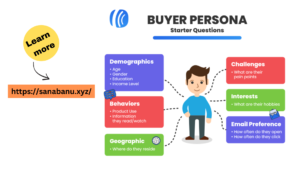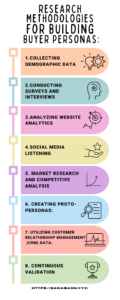How to Build Accurate Buyer Personas
Buyer Personas
Introduction:
In the realm of modern marketing, understanding your audience is paramount. Creating accurate buyer personas is a foundational step towards tailoring marketing strategies that resonate with your target audience. Crafting these personas relies on thorough research and data analysis. In this article, we will delve into effective research methodologies to construct precise and insightful buyer personas.
Understanding Buyer Personas:
Buyer personas are detailed representations of your ideal customers, created through the analysis of demographic information, behaviors, motivations, and goals. These personas help marketers better comprehend their audience’s needs, preferences, pain points, and buying patterns.
Research Methodologies for Building Buyer Personas:
- Collecting Demographic Data:
- Begin by gathering basic demographic information such as age, gender, location, occupation, income level, education, and family status. This data provides a fundamental understanding of your audience’s background.
- Conducting Surveys and Interviews:
- Surveys and interviews with existing customers or target audience members offer qualitative insights. Ask open-ended questions about their challenges, preferences, and decision-making process. This qualitative data is invaluable in shaping personas.
- Analyzing Website Analytics:
- Utilize web analytics tools to gather quantitative data about your website visitors. Examine metrics like traffic sources, time spent on pages, and click-through rates to discern user behavior.
- Social Media Listening:
- Monitor social media platforms to understand audience discussions, interests, sentiments, and engagement with your brand or industry. This helps in identifying trends and gathering real-time insights.
- Utilizing Customer Relationship Management (CRM) Data:
- CRM systems contain a wealth of information about your customers’ interactions with your brand. Analyze purchase history, communication logs, and customer service interactions to identify patterns.
- Market Research and Competitive Analysis:
- Study market trends and analyze competitors to understand the broader industry landscape. Identify gaps or opportunities that can guide persona development.
- Creating Proto-Personas:
- Based on initial data, develop proto-personas – preliminary sketches of potential buyer personas. These can be refined and validated as more data is collected and analyzed.
Refining and Validating Buyer Personas:
- Data Analysis and Pattern Recognition:
- Group and analyze collected data to identify patterns, commonalities, and recurring behaviors. Recognize significant insights that differentiate distinct personas.
- Prioritizing Persona Information:
- Focus on relevant data points that directly impact marketing strategies. Highlight insights that shape messaging, content creation, and communication strategies.
- Continuous Validation:
- Regularly validate personas by comparing them with new data and customer feedback. Ensure that personas remain accurate and reflective of your audience’s evolving characteristics.
- Negative Personas Inclusion:
- Consider negative personas – segments that do not align with your ideal customers. Understanding these segments helps in refining targeting strategies.
- Behavioral Analysis Iterations:
- Conduct iterative analyses of user behavior to refine personas. Review and update persona attributes based on the insights gathered from ongoing behavioral analysis.
- Customer Feedback Integration:
- Continuously incorporate new feedback and testimonials from customers into persona development. Use real-time feedback to validate or adjust persona characteristics.
- Iterative Interviews and Surveys:
- Conduct periodic interviews and surveys with customers or target audience members. This iterative approach helps in uncovering evolving preferences or changing behaviors.
- Comparative Analysis Across Data Sets:
- Compare and validate persona attributes across various data sets, such as CRM data, website analytics, and survey responses. Consistency across multiple sources enhances persona accuracy.
- Qualitative Data Integration:
- Merge qualitative data obtained from customer interactions, interviews, and feedback loops into personas. Real-life anecdotes and insights from qualitative data add depth to personas.
- Persona Testing in Campaigns:
- Implement test campaigns targeting different persona segments to validate the accuracy of persona assumptions. Analyze campaign performance metrics for alignment with persona attributes.
- Social Media Validation:
- Monitor ongoing conversations on social media channels related to your industry or brand. Validate persona attributes based on real-time discussions and interactions.
- Customer Journey Alignment:
- Validate persona traits by mapping them to the actual customer journey. Ensure that personas align with the observed behaviors and touchpoints encountered throughout the customer journey.
- A/B Testing Persona Assumptions:
- Conduct A/B testing experiments to validate assumptions about persona preferences or behaviors. Test different messaging or content strategies to see which resonates more with specific personas.
- Continual Persona Evolution:
- Acknowledge that personas are not static and require continual evolution. Regularly revisit and update personas based on new data, market shifts, or changes in customer behavior.
- Cross-Departmental Validation:
- Collaborate across departments to validate persona characteristics. Input from sales, customer service, and product teams can provide varied perspectives, refining persona accuracy.
- Feedback Loop Closure:
- Close the feedback loop by using insights from persona validation to improve products, services, or marketing strategies. Applying validated persona insights ensures continuous improvement.
- Periodic Review and Updates:
- Establish a schedule for periodic review and updates of personas. Aim for regular intervals to ensure personas remain reflective of current audience characteristics.
Benefits of Accurate Buyer Personas:
- Targeted Marketing Campaigns:
Precise personas enable tailored marketing messages, content, and campaigns that resonate with specific audience segments.
- Improved Product Development:
Understanding customer needs and pain points aids in developing products or services that align with their preferences.
- Enhanced Customer Experience:
Meeting the needs of distinct buyer personas fosters a personalized and satisfying customer experience, leading to increased loyalty and retention.
- Improved Customer Acquisition:
Precise personas help in identifying high-potential leads more efficiently. Targeting the right audience segments based on accurate personas enhances customer acquisition efforts and boosts conversion rates.
- Alignment of Sales and Marketing Efforts:
Accurate personas ensure alignment between sales and marketing teams by providing a shared understanding of the target audience. This alignment results in cohesive messaging and strategies across departments.
- Better Customer Segmentation:
Accurate personas facilitate more refined customer segmentation strategies. This segmentation allows for customized approaches, promotions, and offerings tailored to distinct groups, enhancing relevance and engagement.
- Reduced Marketing Waste:
Targeting accurately defined personas minimizes marketing waste by directing efforts and resources towards segments most likely to convert. This optimizes marketing spend and improves overall efficiency.
- Agile Response to Customer Needs:
Understanding buyer personas enables businesses to respond swiftly to evolving customer needs and market dynamics. This adaptability ensures that products, services, and strategies remain relevant and competitive.
- Improved Cross-Selling and Up-Selling Opportunities:
Accurate personas provide insights into additional products or services that different segments might be interested in. This knowledge aids in creating cross-selling or up-selling opportunities to maximize customer value.
- Effective Customer Journey Mapping:
Personas assist in mapping customer journeys accurately. Understanding personas’ touchpoints and interactions at each stage of the journey helps in optimizing experiences and addressing pain points effectively.
- Reduced Time-to-Market:
Insights from accurate personas streamline decision-making processes. Businesses can develop and launch targeted campaigns or products more efficiently, reducing the time required to bring innovations to market.
- Increased Brand Loyalty:
By addressing specific needs and pain points of distinct personas, businesses can build stronger emotional connections with their audience. This emotional resonance fosters brand loyalty and advocacy.
- Identification of New Market Opportunities:
Detailed personas often reveal underserved or emerging market segments. Identifying these opportunities allows businesses to tailor strategies and offerings to tap into new markets effectively.
- Mitigation of Risk:
Accurate personas serve as informed guides, reducing the risk of misdirected strategies or misaligned initiatives. Businesses make decisions with a clearer understanding of their audience’s preferences and behaviors.
Conclusion:
Creating accurate buyer personas is a foundational element in developing effective marketing strategies. By employing diverse research methodologies, gathering both qualitative and quantitative data, and consistently refining and validating personas, businesses can gain invaluable insights into their target audience. Accurate buyer personas serve as guiding beacons, enabling businesses to create targeted and impactful marketing efforts that resonate with their ideal customers, ultimately driving success and growth.
click to see another interesting blog
What are buyer personas?
Explanation of buyer personas as fictional representations of ideal customers based on market research and real data.
Why are buyer personas important in marketing?
Discussing the significance of buyer personas in understanding customer needs, tailoring marketing strategies, and enhancing product/service offerings.
How do you create buyer personas?
Explaining the process of developing buyer personas, including conducting research, gathering data, analyzing demographics, behaviors, and pain points.


